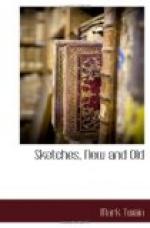6. Does the reader suppose that that was the end of it? Does he suppose those diffident Fishers we: satisfied? Let the evidence show. The Fishers were quiet just two years. Then they came swarming up out of the fertile swamps of Florida with their same old documents, and besieged Congress once more. Congress capitulated on the 1st of June, 1860, and instructed Mr. Floyd to overhaul those papers again, and pay that bill. A Treasury clerk was ordered to go through those papers and report to Mr. Floyd what amount was still due the emaciated Fishers. This clerk (I can produce him whenever he is wanted) discovered what was apparently a glaring and recent forgery in the paper; whereby a witness’s testimony as to the price of corn in Florida in 1813 was made to name double the amount which that witness had originally specified as the price! The clerk not only called his superior’s attention to this thing, but in making up his brief of the case called particular attention to it in writing. That part of the brief never got before Congress, nor has Congress ever yet had a hint of forgery existing among the Fisher papers. Nevertheless, on the basis of the double prices (and totally ignoring the clerk’s assertion that the figures were manifestly and unquestionably a recent forgery), Mr. Floyd remarks in his new report that “the testimony, particularly in regard to the corn crops, demands A much higher allowance than any heretofore made by the Auditor or myself.” So he estimates the crop at sixty bushels to the acre (double what Florida acres produce), and then virtuously allows pay for only half the crop, but allows two dollars and a half a bushel for that half, when there are rusty old books and documents in the Congressional library to show just what the Fisher testimony showed before the forgery—viz., that in the fall of 1813 corn was only worth from $1.25 to $1.50 a bushel. Having accomplished this, what does Mr. Floyd do next? Mr. Floyd ("with an earnest desire to execute truly the legislative will,” as he piously remarks) goes to work and makes out an entirely new bill of Fisher damages, and in this new bill he placidly ignores the Indians altogether puts no particle of the destruction of the Fisher property upon them, but, even repenting him of charging them with burning the cabins and drinking the whisky and breaking the crockery, lays the entire damage at the door of the imbecile United States troops down to the very last item! And not only that, but uses the forgery to double the loss of corn at “Bassett’s Creek,” and uses it again to absolutely treble the loss of corn on the “Alabama River.” This new and ably conceived and executed bill of Mr. Floyd’s figures up as follows (I copy again from the printed United States Senate document):




